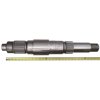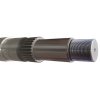I'm confused, do you mean sprocket or internal spline? A sprocket can be cut on a CNC or pattern tracer plasma or oxy/fuel torch and flame hardened if required. If it's a spline, what spline? Maybe something from an AG tractor could be made to work. Pics. would be a BIG help.
Hi Dave, I don't have pictures of my parts. I'm not taking the machine apart unless I have means of getting it back together. I need it. I can limp around with it using the boom as a crutch to move the dead side.
I have been asking crawler suppliers if there is a newer sprocket that fits the Case type C chain. Nope. Kind of surprising that they only used this track chain for a rather limited number of years. I'd thought that possibly I could make a flange for the shaft and fit a bolt on sprocket.
From what I've read Dana designed these with a 29 tooth spline on the inside of the sprocket to mount to the shaft. The spline is rather fine and delicate. I don't know what type or exact size of spline it is.
Looking at the shaft photos it appears that the spline is about 2.25" wide and 3 to 3.25 OD. The threaded end is 2.5 inches in diameter.
The drive sprocket appears to possibly pilot on the larger portion of the shaft next to the inner pillow block bearing which is sensible. On the outer side of the sprocket there is a collar that slides onto the shaft and inside a counterbore in the sprocket. It should also be a snug fit - but I do not know this to be true or not. The outer bearing retaining nut presses the outer pillow block bearing against the collar and sprocket against the inner pillow block bearing.
If the sprocket is piloted on the shaft and collar - I believe a rough patch could be done where holes could be made in the sprocket - outside of the webs from the spokes and then plug welds could be used to lock the sprocket to the shaft at the splines. I don't know if they would be sufficient. Woe be the person who needs to access the inner bearing later. I was hoping to not perform such a brutal patch job. I've been told by a crawler supply center that often the shaft can be used on 2 sprockets before it needs replacing. I called the prior owner of my machine to see if he worked on the drives before - he had not. If I could determine what the shaft spline is - I could get a splined bushing and bore the sprocket as needed. Then press the bushing into the sprocket and weld it in via holes in the sprocket. The hub of the sprocket near the outside pillow block bearing appears to measure 5" inches in outside diameter. If the spline is 3.25 OD then an internally splined bushing is going to be roughly 4" in diameter leaving only about 1/2" an inch of sprocket wall thickness for the new shaft collar to support side loads on the sprocket. Not a lot of material. Maybe enough. It would be nice to have a stripped sprocket to rework and have ready to use.
Here are some photos to get an idea of what is there.



This is a new shaft at the sprocket end







